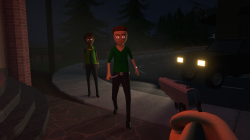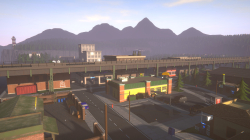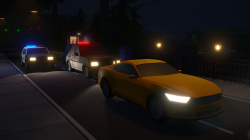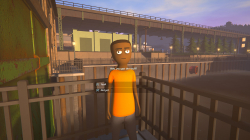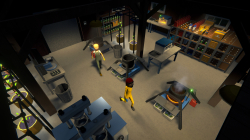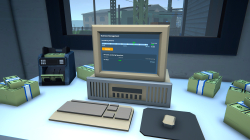
Schedule I
All trademarks belong to their respective owners.Details
A Digital Maze of Mind and Machine
Some games aim to challenge your reflexes. Schedule I challenges your perception of reality. This experimental psychological game doesn’t offer easy explanations or structured gameplay—it traps you in a malfunctioning virtual system where logic crumbles and meaning is intentionally distorted. It’s a puzzle without an obvious goal, an experience that breaks itself to provoke thought rather than to entertain in traditional ways.
On first launch, players find themselves inside a decaying simulation. What appears to be a research facility begins glitching seconds after you enter, with dialogue fragments, flickering environments, and corrupted UI flooding the screen. The game world isn’t just unstable—it’s hostile to understanding. There’s no clear path forward, no checklist of tasks. You’re left alone in a system that’s actively falling apart, and your only tools are curiosity and patience.
Gameplay Built from Confusion
Instead of levels or missions, Schedule I offers looping corridors, strange terminals, and abstract environmental changes based on player behavior. Objects appear or vanish depending on where you look. Sounds play backward. Your previous actions may rewrite future interactions, creating a gameplay loop that’s uniquely tailored to your decisions—or errors.
The control scheme remains familiar—WASD movement, mouse interaction—but nothing else does. The interface fades in and out. Dialogue sometimes plays in reverse. There are puzzles, but they don’t present themselves clearly. Some are solved through file manipulation, others through emotional response triggers. You don’t just play Schedule I; you investigate it.
Free, Unblocked, and Unfiltered
Despite its ambitious design, the game is completely free. Players can download it from its official platform or run an unblocked version directly in-browser. Whether you're trying to access it from school, work, or on a shared network, it runs with minimal setup and no need for elevated permissions.
The game is available across multiple platforms. Windows and Mac versions are stable, while Android users can play via emulator or supported cloud platforms. There’s no native iOS or console support yet, but unofficial builds and mods have helped bring the experience to broader audiences.
Audio-Visual Disturbance as a Feature
Graphically, Schedule I is stripped down but intentional. It mimics corrupted data environments with flashing static, uneven lighting, and visual tearing that grows worse the longer you play. Each scene looks less like a room and more like a memory on the verge of erasure. It isn’t pretty—but it’s not supposed to be.
The sound design is equally jarring. You’ll hear mechanical drones, synthetic voices, white noise, and sometimes just silence that lasts long enough to create unease. The audio doesn’t follow traditional rules—it reacts dynamically, sometimes even leading you toward the next event. Or misleading you entirely.
Mods, Cheats, and Community Influence
Since the game is open for modification, a growing player community has contributed cheats, mods, and alternate interpretations. Some mods inject new environmental effects, unlock hidden scenes, or restore redacted content. Cheats can trigger alternate paths or remove barriers, but in most cases, they don’t simplify the experience—they reshape it.
The developers encourage exploration beyond the game itself. Players have found clues hidden in installation files, custom triggers embedded in the code, and even external links that lead to real-world puzzles. Schedule I isn’t confined to the screen—it leaks into your desktop and browser if you let it.
Verdict
Schedule I doesn’t hold your hand—it barely acknowledges you. But that’s exactly what makes it worth exploring. It’s an artful descent into fractured code and digital anxiety, built for players who enjoy uncovering stories hidden beneath surfaces. If you’re looking for something polished or conventional, this won’t satisfy. But if you're eager to download something truly different, immerse yourself in an unfiltered psychological spiral, and perhaps even mod the madness yourself, Schedule I is a must-play.
How to download and play Schedule I
Schedule I is free to download from its official site or trusted indie platforms. It can also be played unblocked in-browser, ideal for use in restricted environments. The downloadable version is portable and requires no installation beyond extracting files.
The game supports Windows and macOS directly. Android users can play through emulator or cloud-based gaming platforms. iOS and console platforms are currently unsupported, though some players use third-party tools to access it.
To install, download the zip package, extract its contents, and launch the main executable. No setup wizard or admin access is required. Minimum system requirements: Windows 8+, 4GB RAM, integrated graphics; macOS 10.12+; Android 9.0+ with 3GB RAM for emulator/cloud access. Cheats and mods are available through community channels. Unblocked access is supported via browser or remote play options.
Pros
completely free to download and play with no microtransactions;
available on PC, Mac, and Android (via cloud/emulator);
fully unblocked for use in restricted environments like schools or offices;
supports mods and custom content created by the player community;
atmosphere that evolves dynamically based on user actions;
audio and visual design push boundaries of interactive horror;
files and gameplay integrate for a deeper, meta-level experience;
replay value enhanced by unpredictable changes in each session.
Cons
no tutorial or guidance may leave some players lost early on;
not compatible with iOS or gaming consoles without workaround tools;
technical instability is part of the experience but may frustrate some users;
abstract narrative may not appeal to players seeking clear progression.

